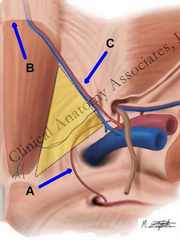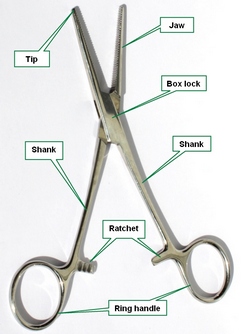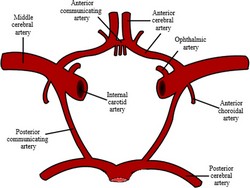
Medical Terminology Daily (MTD) is a blog sponsored by Clinical Anatomy Associates, Inc. as a service to the medical community. We post anatomical, medical or surgical terms, their meaning and usage, as well as biographical notes on anatomists, surgeons, and researchers through the ages. Be warned that some of the images used depict human anatomical specimens.
You are welcome to submit questions and suggestions using our "Contact Us" form. The information on this blog follows the terms on our "Privacy and Security Statement" and cannot be construed as medical guidance or instructions for treatment.
We have 524 guests online

Jean George Bachmann
(1877 – 1959)
French physician–physiologist whose experimental work in the early twentieth century provided the first clear functional description of a preferential interatrial conduction pathway. This structure, eponymically named “Bachmann’s bundle”, plays a central role in normal atrial activation and in the pathophysiology of interatrial block and atrial arrhythmias.
As a young man, Bachmann served as a merchant sailor, crossing the Atlantic multiple times. He emigrated to the United States in 1902 and earned his medical degree at the top of his class from Jefferson Medical College in Philadelphia in 1907. He stayed at this Medical College as a demonstrator and physiologist. In 1910, he joined Emory University in Atlanta. Between 1917 -1918 he served as a medical officer in the US Army. He retired from Emory in 1947 and continued his private medical practice until his death in 1959.
On the personal side, Bachmann was a man of many talents: a polyglot, he was fluent in German, French, Spanish and English. He was a chef in his own right and occasionally worked as a chef in international hotels. In fact, he paid his tuition at Jefferson Medical College, working both as a chef and as a language tutor.
The intrinsic cardiac conduction system was a major focus of cardiovascular research in the late nineteenth and early twentieth centuries. The atrioventricular (AV) node was discovered and described by Sunao Tawara and Karl Albert Aschoff in 1906, and the sinoatrial node by Arthur Keith and Martin Flack in 1907.
While the connections that distribute the electrical impulse from the AV node to the ventricles were known through the works of Wilhelm His Jr, in 1893 and Jan Evangelista Purkinje in 1839, the mechanism by which electrical impulses spread between the atria remained uncertain.
In 1916 Bachmann published a paper titled “The Inter-Auricular Time Interval” in the American Journal of Physiology. Bachmann measured activation times between the right and left atria and demonstrated that interruption of a distinct anterior interatrial muscular band resulted in delayed left atrial activation. He concluded that this band constituted the principal route for rapid interatrial conduction.
Subsequent anatomical and electrophysiological studies confirmed the importance of the structure described by Bachmann, which came to bear his name. Bachmann’s bundle is now recognized as a key determinant of atrial activation patterns, and its dysfunction is associated with interatrial block, atrial fibrillation, and abnormal P-wave morphology. His work remains foundational in both basic cardiac anatomy and clinical electrophysiology.
Sources and references
1. Bachmann G. “The inter-auricular time interval”. Am J Physiol. 1916;41:309–320.
2. Hurst JW. “Profiles in Cardiology: Jean George Bachmann (1877–1959)”. Clin Cardiol. 1987;10:185–187.
3. Lemery R, Guiraudon G, Veinot JP. “Anatomic description of Bachmann’s bundle and its relation to the atrial septum”. Am J Cardiol. 2003;91:148–152.
4. "Remembering the canonical discoverers of the core components of the mammalian cardiac conduction system: Keith and Flack, Aschoff and Tawara, His, and Purkinje" Icilio Cavero and Henry Holzgrefe Advances in Physiology Education 2022 46:4, 549-579.
5. Knol WG, de Vos CB, Crijns HJGM, et al. “The Bachmann bundle and interatrial conduction” Heart Rhythm. 2019;16:127–133.
6. “Iatrogenic biatrial flutter. The role of the Bachmann’s bundle” Constán E.; García F., Linde, A.. Complejo Hospitalario de Jaén, Jaén. Spain
7. Keith A, Flack M. The form and nature of the muscular connections between the primary divisions of the vertebrate heart. J Anat Physiol 41: 172–189, 1907.
"Clinical Anatomy Associates, Inc., and the contributors of "Medical Terminology Daily" wish to thank all individuals who donate their bodies and tissues for the advancement of education and research”.
Click here for more information
- Details
The word [pathology] is formed by two components. The root term [-path-] arises from the Greek [πάθος], meaning “suffering”. The term [πάθος], or [pathos] was first used by Galen of Pergamon (129AD - 200AD) (see accompanying image) to denote an alteration of a vital process. The suffix [-(o)logy] also has Greek origin from [logos] or [λόγος], meaning a "book", a "treatise" or "to study". Therefore [pathology] or [παθολογία] is the “study of disease or conditions”. In simpler terms the word [pathology] is also used as a synonym for "sickness", "disease", or "condition".
The root term [-path-] can be found in many medical terms such as:
- Pathology: Study of disease
- Pathophysiology: This combined root adds the root term [-phys-] meaning “function” Study of the function of disease (a disease in action)
- Pathognomonic: See definition here
- Pathogenesis: The suffix [-(o)genesis] means “creation”, or “origin”. Origin of a disease
Original image courtesy of the National Library of Medicine. Public Domain. Clicking on the image will take you to an article on this website on Galen of Pergamon.
- Details
Franz Kaspar Hesselbach (1759 – 1816). German physician, surgeon, and anatomist. Hesselbach was born in Bavaria in 1759. At the age of 19 he became an apprentice to Karl Von Siebold (1736 - 1807), a German surgeon, obstetrician and anatomist. He worked with him as an unpaid assistant for six years until 1789 when he was hired as a prosector.
Hesselbach became a lecturer on anatomy at the University of W?rzburg and a surgical assistant at the Juliusspital at W?rzburg. Later Hesselbach became a professor of Surgery at the same university.
Hesselbach’s name is eponymically tied to many structures, most of them related to hernia, an area where he is best known. In 1806 he published a treatise on hernia (Anatomisch-chirurgische Abhandlung ?ber den Urspurng der Leistenbr?che) “Anatomical and surgical treatise on the origin of Hernias”. These structures are:
- Hesselbach’s fascia: the cribriform fascia covering the saphenous hiatus of the thigh
- Hesselbach’s ligament: also known as the interfoveolar ligament
- Hesselbach’s triangle: site for direct inguinal hernia
- Hesselbach’s hernia: a femoral hernia protruding through the cribriform fascia
Hesselbach also described the femoral hernia in 1798 and distinguished between direct and indirect inguinal hernias.
In 1807 Hesselbach’s contributions were acknowledged and he was conferred the degree of Doctor of Surgery. During his life Hesselbach published several books, treatises, and papers.
A depiction of Hesselbach has not been found (yet) so we publish an image of his eponymic “triangle”. If you click on the image, you will see an original image from Hesselbach's book.
Sosurces:
1. "Franz Kaspar Hesselbach (1759–1816): Anatomist and Surgeon" R. Shane Tubbs et al W J Surg (2008) 32:11 2527-2529
2. "Groin Hernia Anatomical and Surgical History" McClusky DA, et al Arch Surg. 2006; 141(10):1035-1042
3. "Eponyms in groin surgery" Ellis, H. Surgery (Oxford) (2006) 24:8, 257–259
4. "Franz Kaspar Hasselbach (1759–1816)" Agarwal, AK; Mukherjee, R. Indian J. Surg (2008); 70:96–98
Primary Image property of: CAA.Inc. Artist: M. Zuptich.
- Details
The word [version] comes from the Latin [versum / vertere] meaning "to turn" or "to turn around" (see the use of this Latin root in the word "vertebra"). In anatomy, version is the angulation (or turning) of an organ or a structure as a unit. The term is also used to denote the "turning" of a fetus "in utero" by active manipulation to allow proper birth.
Normally, the cervix of the uterus is anteversed or has an "anterior version". This means that the body and uterine cervix are tilted anteriorly (as a unit). Because of this in a female in the anatomical position, the fundus of the uterus looks almost anteriorly, while the main axis of the cervix points towards the coccyx. See the accompanying image.
The opposite, pathological presentation, is retroversion, where the uterus as a unit is tilted posteriorly. The angulation between the main axis of the uterine body and the main axis of the cervix is normal, but the organ as a unit is tilted posteriorly. Varying degrees of retroversion can cause varying degrees of infertility, a condition known vernacularly as a "slippery uterus".
- Details
The word [forceps] is used to denote a grasping-type surgical instrument. The origin of the word has been heavily discussed. It seems that it arises from the combination of the Latin terms [formus], meaning "hot" and [capere]. meaning "to hold", a device to hold something hot. Originally, the word was first used by Roman blacksmiths and was a pair of articulated tongs.
In modern terminology, the singular and plural form for the word is the same: [forceps], although there is an older plural form that is sometimes used: [forcipes]
According to Skinner (1970) the first forceps used in the medical arena were dental extraction forceps. The number of surgical forceps has increased over time. Today there are many types of forceps. Following are some of them:
- Thumb forceps: Tissue (toothed) or dressing (serrated) forceps
- Hemostatic forceps: Forceps designed for hemostasis and dissection. These usually have a locking mechanism and are of the ring-handle type
- Obstetrical forceps: Articulated forceps use to deliver a fetus
- Sponge forceps: Forceps to be used with swabs and sponges
- Right-angle forceps: A family of forceps which have an angled jaw (not necessarily right-angled) used for dissection, hemostasis, and grasping
- Specialty forceps: Forceps that have been especially designed for use on an organ or a specific step of a surgical procedure, such as hysterectomy forceps, tenacula, lung forceps, liver forceps, etc.
Click on the image to see a better detail of the anatomy of a hemostatic forceps.
Sources:
1. "The Origin of Medical Terms" Skinner 1970
2. Codman: Surgical Product Catalog 2000
- Details
The posterior communicating artery is a bilateral artery that communicates the internal carotid artery with the posterior cerebral artery. This creates an anastomosis between the vascular arterial territory of the vertebral artery and that of the internal carotid artery, completing the arterial circle of Willis.
The posterior communicating artery has high variability in its diameter, which can be thin or extremely thick, including the fact that you can find a thin one on one side of the brain and a thick one contralaterally. It is one of the sites for intracranial aneurysm. For more information on the anatomical variations of the posterior communicating artery click here.
Sources:
1. "An Overview of Intracranial Aneurysms" Keedy, A Mcgill J Med. 2006 July; 9(2): 141–146
2. "Observations on the length and diameter of the arteries forming the circle of Willis" Kamath S 1981 J Anat 133; 3:419-423"
3. "Aneurysms of the posterior communicating artery and oculomotor paresis" Sonil, SR J Neurol Neurosurg Psych 1974;37(4): 475–484
Image in the public domain, modified from the original courtesy of Wikipedia.
- Details
The root term [-cost-] arises from the Latin [costa / costalis] meaning "rib". First used by Galen, this root term is used in medical words such as:
- Costochondral: A combination of root terms, adding [-chondr-] meaning "cartilage". Refers to the joint between the bony rib and its cartilage
- Costal margin: Refers to the lower anterior margin of the thorax formed by the cartilage of ribs 7 through 10
- Intercostal: The prefix [inter-] means "between". Between ribs
- Subcostal: The prefix [sub-] means "below". Below the rib
- Costovertebral joint: A joint between the head of a rib(s) and a vertebra(e)
- Costotransverse joint: A joint between the articular portion of the tubercle of a rib and the transverse process of a vertebra






